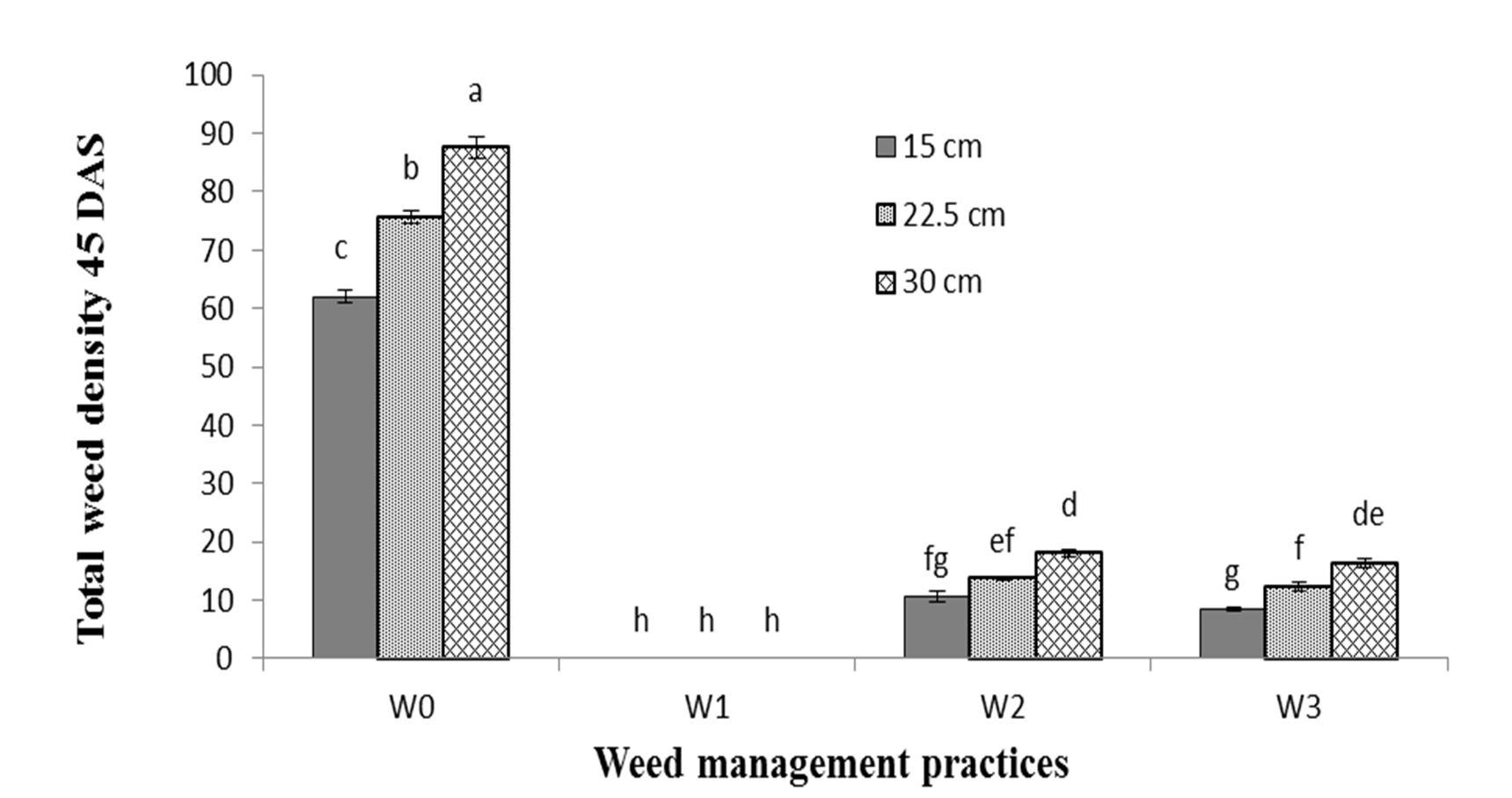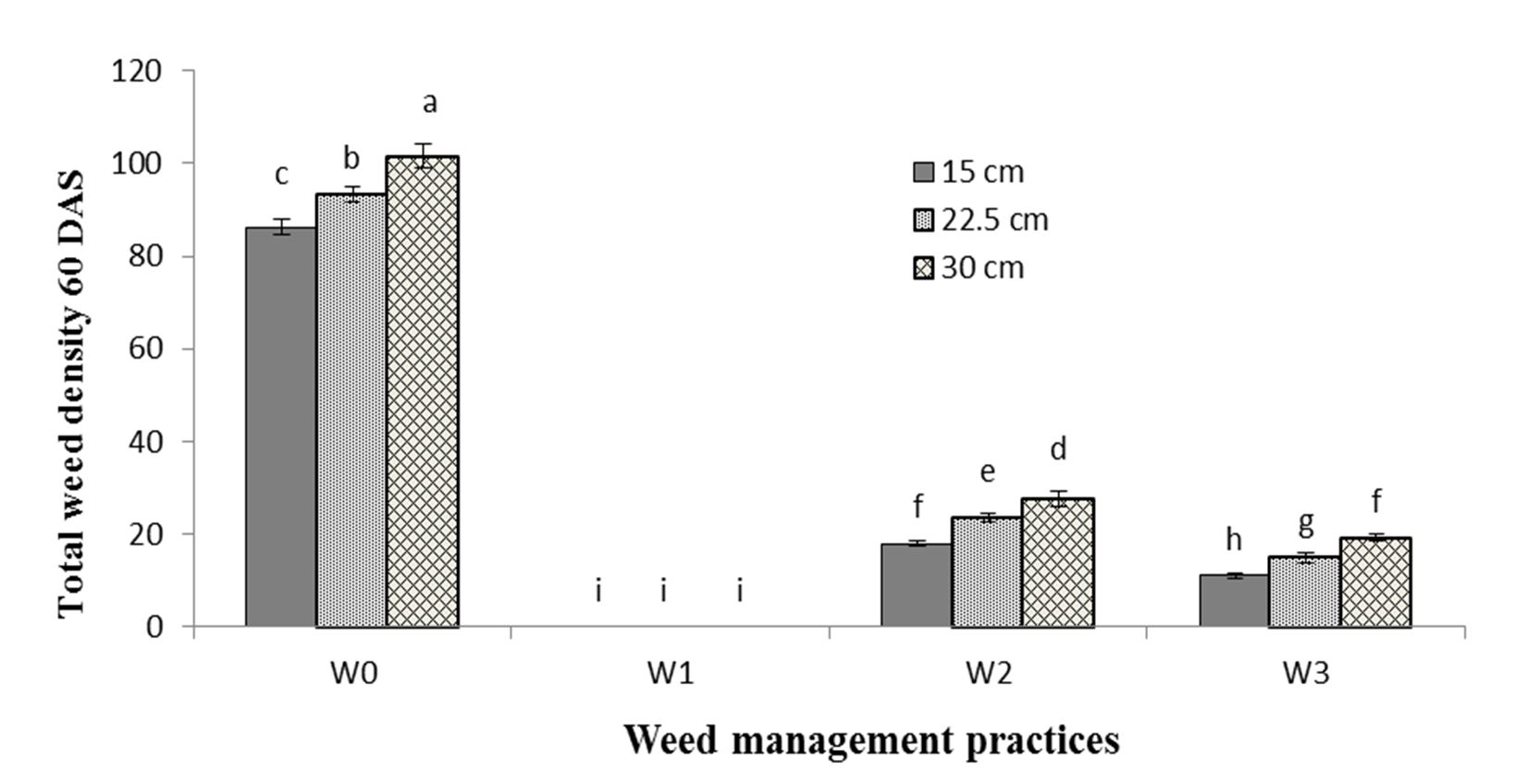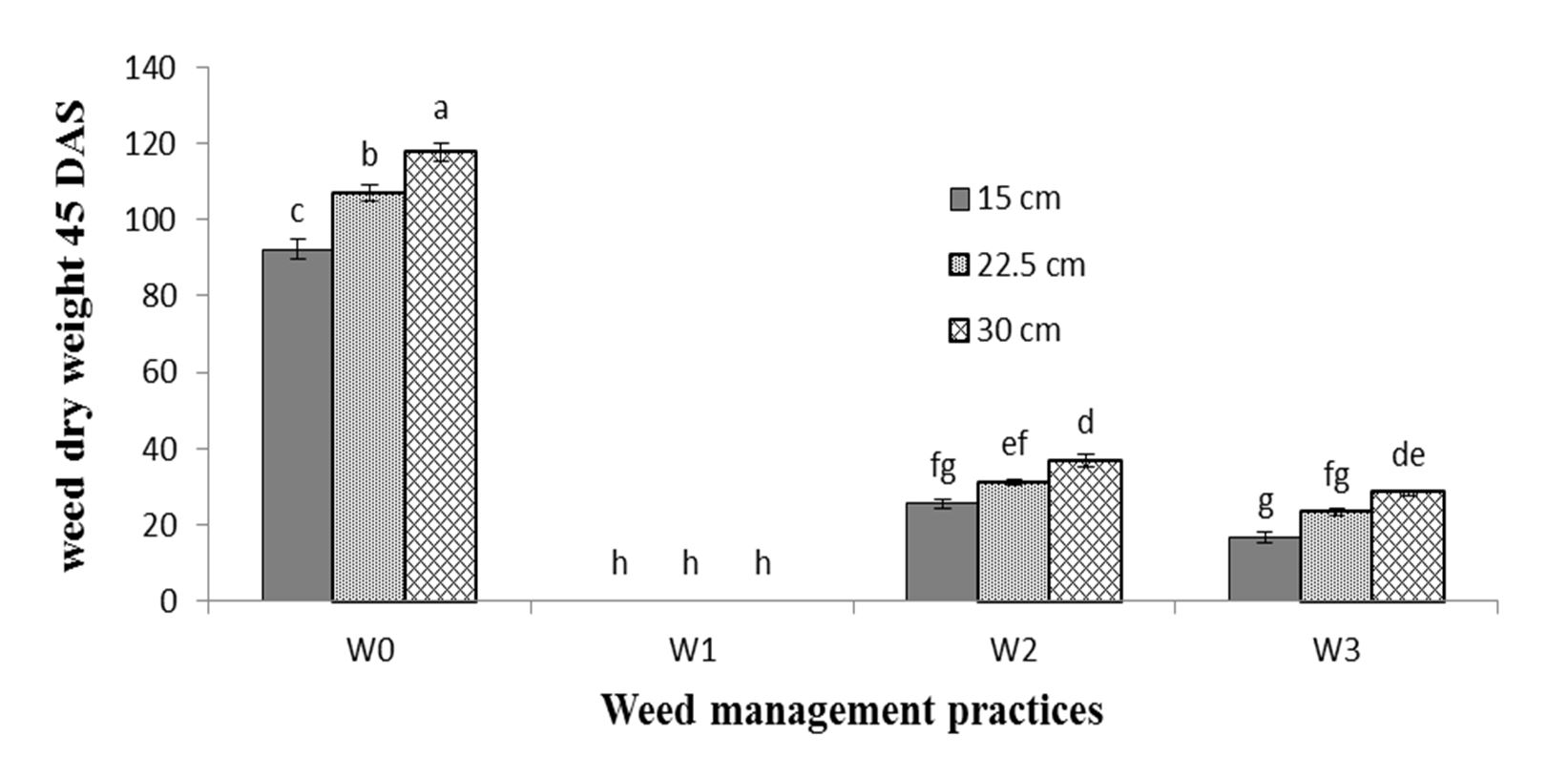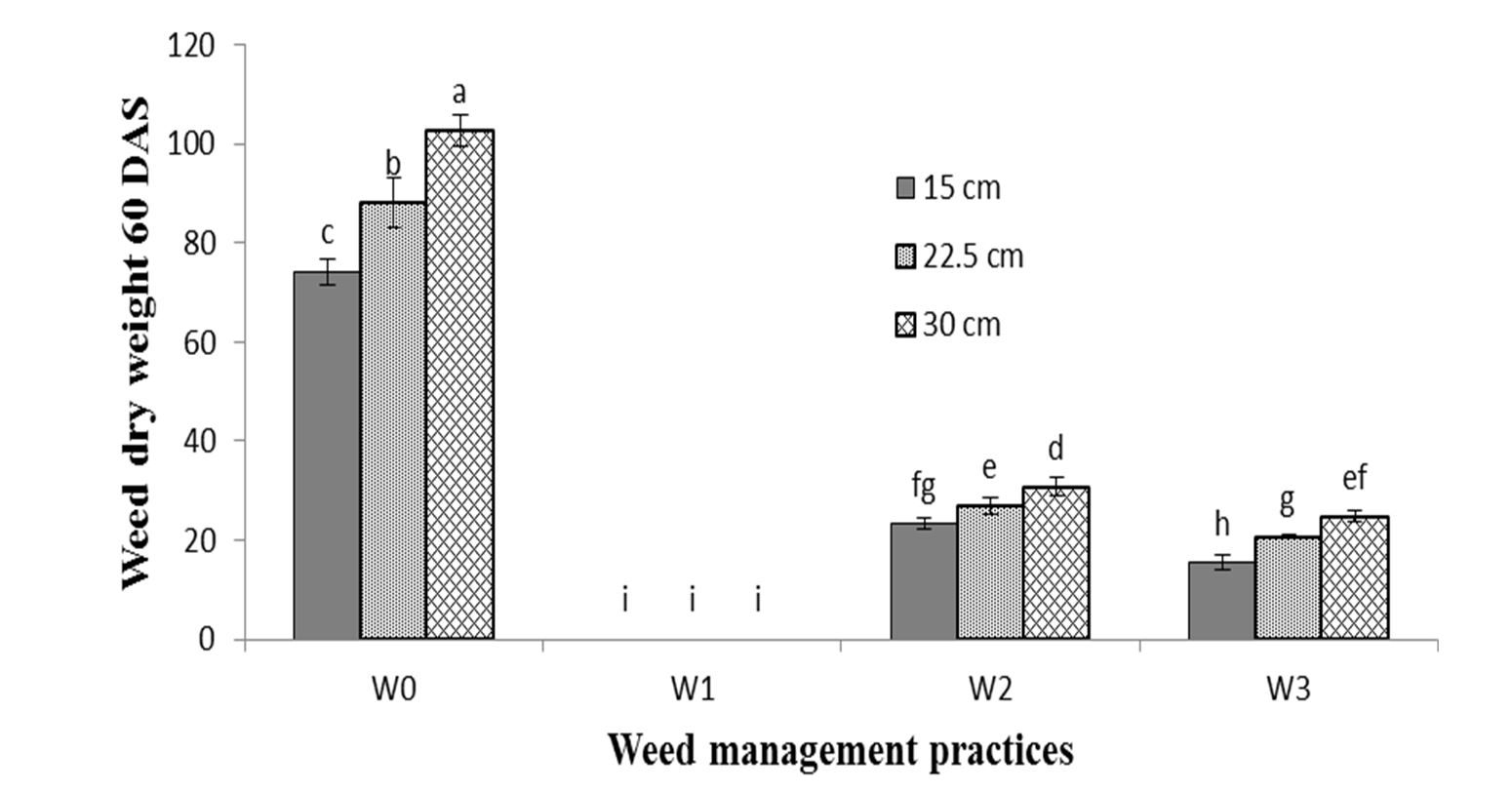M. Ali, H.M.U. Farooq, S. Sattar, T. Farooq, I. Bashir
Abstract. Direct-seeded rice alterna-tive to transplanted rice system is less labor intensive, easier to plant, and consume less water. The advantages of direct-seeded rice have been proved by many research workers, but yet it is not very much adapted by farmers. Weeds reduce cost effectiveness of direct-seeded rice. A study was conducted to evaluate the effect of different row spacing and weed management practices on the performance of aerobic rice at Agronomic Research Area, University of Agriculture, Faisalabad, during summer season of 2013. Fine rice variety ‘Super Basmati’ was used for experiment in a randomized complete block design with factorial arrangements with three replications. Hand drill sowing with row spacing comprised 15 cm, 22.5 cm, and 30 cm was practiced. Weed scouting hoeing (hand pulling is weed free treatment for comparison with the others and hoeing is a type of mechanical weeding) and pre-emergence herbicide, followed by post-emergence herbicide, were the weed management practices. Weeds data and rice yield parameters were measured. Maximum reduction in weed density (86%) and weed dry weight (79%) was recorded for pre-emergence, followed by for post-emergence herbicide in crop sown at 15 cm row spacing.
Keywords: Super Basmati; weed growth; agronomic practices; treatments.
View full article (HTML)
Effect of row spacing and weed management practices on the performance of aerobic rice
M. Ali1, H.M.U. Farooq2, S. Sattar3*, T. Farooq4, I. Bashir5,6*
1Department of Agronomy, University of Agriculture, Faisalabad, Pakistan
2University of Agriculture, Faisalabad, Pakistan
3Department of Plant breeding and genetics, University of Agriculture, Faisalabad, Pakistan
4College of Horticulture and forestry sciences, Huazhong Agricultural University, Wuhan, China
5Faculdade de Agronomia Eliseu Maciel, Universidade Federal de Pelotas, Brasil
6Embrapa Clima Temperado, Pelotas, RS, Brasil
*E-mail: Ikram.pbg@gmail.com
Received: Dec. 17, 2018. Revised: Mar. 29, 2019. Accepted: Apr. 19, 2019. Published online: Oct. 10, 2019
Abstract. Direct-seeded rice alterna-tive to transplanted rice system is less labor intensive, easier to plant, and consume less water. The advantages of direct-seeded rice have been proved by many research workers, but yet it is not very much adapted by farmers. Weeds reduce cost effectiveness of direct-seeded rice. A study was conducted to evaluate the effect of different row spacing and weed management practices on the performance of aerobic rice at Agronomic Research Area, University of Agriculture, Faisalabad, during summer season of 2013. Fine rice variety ‘Super Basmati’ was used for experiment in a randomized complete block design with factorial arrangements with three replications. Hand drill sowing with row spacing comprised 15 cm, 22.5 cm, and 30 cm was practiced. Weed scouting hoeing (hand pulling is weed free treatment for comparison with the others and hoeing is a type of mechanical weeding) and pre-emergence herbicide, followed by post-emergence herbicide, were the weed management practices. Weeds data and rice yield parameters were measured. Maximum reduction in weed density (86%) and weed dry weight (79%) was recorded for pre-emergence, followed by for post-emergence herbicide in crop sown at 15 cm row spacing.
Keywords: Super Basmati; weed growth; agronomic practices; treatments.
INTRODUCTION
Rice (Oryza sativa L.) is main food source and more than half of world population subsists on it. Rice is grown in 114 countries and 90% of total crop is produced by Asian farmers (FAO, 2008).
In Pakistan, area under rice crop is estimated 2.31 million hectares, with annual production of 5.54 million tons (Govt. of Pakistan, 2013).
There are various growing methods of rice in the world, i.e. transplanting and direct seeding. In direct seeding of rice (DSR), establishment of rice crop is dependent on seeds sown directly in the field instead of transplanting seedlings from the nursery.
In transplanting method of rice more labor and water is required (Bouman et al., 2007). Other problems in this method include, increasing cost of diesel and electricity, climatic changes, physio-chemical problem of soil and declined water table (Vörösmarty et al., 2000). In water-short lowland rice production systems, aerobic rice cultivation is a better choice.
An appropriate weed manage-ment strategy has always been a preferable choice and key element to make a success in aerobic way of rice production. Weed infestation caused complete failure of aerobic rice and extremely vulnerable to weeds when compared with other rice production system (Jayadeva et al., 2011). Paddy yield losses in aerobic rice due to weeds ranges from 15 to 20% on average, but in severe cases these losses may exceed 50% or even 100% when no weed control measures were adopted (Mishra and Singh, 2007).
Although aerobic rice has been under cultivation in many regions of the world (Rao et al., 2007), yet its adoption in Pakistan has been restricted due to unavailability of successful weed control strategies.
Different weed control methods have been practiced to decrease the weed pressure in direct seeded (aerobic) rice (Phuong et al., 2005; Chauhan et al., 2010), which is manual, mechanical, and chemical control.
Manual weeding, though effective, is getting increasingly difficult due to labor scarcity, rising wages and its dependence on weather conditions.
Mechanical weeding is almost universally practiced on row seeded rice, since inter row cultivation, with either animal or tractor drawn equipment, reduces time in weeding and minimizes crop damage. Effective weed management practices are an important requirement in DSR culture, with herbicide application seemingly indispensable (Rao et al., 2007).
Several studies have concluded that most efficient, practical and eco-nomic method of weed management is chemical control (Hussain et al., 2008). Application of pendimethalin and benthiocarb can inhibit annual grass and broad-leaved weed species due to their residual activity in soil. In this regard, pendimethalin and benthiocarb must be used at the time rice seed has imbibed water, but prior to the emergence of rice and weeds (Jordan et al., 1998).
Use of bispyribac-sodium herbi-cide 30 g a.i. ha-1 after 10-14 days of sowing was highly selective for the control of number of damaging weeds, including grasses, broad leaves and sedges associated with direct seeded rice. It increased 12.30 % in straw and 17.45% in grain yield, as compared to un-weeded rice field (Khaliq et al., 2011).
However, contradictorily to other cereals, application of a single particular herbicide seldom meets adequate weed control in aerobic rice. Use of narrow row spacing in direct seeded rice also significantly increased efficacy of different weed management practices.
It was reported that when row spacing was increased from 15-18 cm to 25-30 cm, decrease in rice grain yield was as about 30% (Chauhan and Johnson, 2011). It was observed in a study that rice grown in 30 cm spaced rows produce less yield and more weed biomass, as compared to 15 cm and 10-20-10 cm spaced rows (Chauhan et al., 2011).
Modern agriculture emphasizes on goal oriented productivity, sustainability and economic viability of the system.
The demand of such an approach is to evaluate a weed management strategy that is selective, efficient and cost effective with little or no adverse effects on ecosystem. The information about weed management practices with aerobic rice grown at different row spacing is scanty.
Therefore, this experiment was conducted to evaluate the effective-ness of different weed management practices for direct seeded (aerobic) rice at varying row spacing, under the prevailing conditions of Faisalabad.
MATERIALS AND METHODS
Site description
The proposed study was conducted at agronomic research farm, University of Agriculture Faisalabad, during summer season of 2013. The pH of saturated soil paste was 8.1 and total soluble salts were 0.40 dSm-1. The organic matter, total nitrogen, available phosphorus and potassium were 0.9%, 0.061%, 9 and 104 ppm, respectively. Faisalabad region features an arid climate with mean annual rainfall of 200 mm.
Experiment design
The experiment was laid out in randomized complete block design (RCBD) with factorial arrangement with three replications. A net plot size was 3.6 m × 6.0 m.
The land was prepared by ploughing the field four times, followed by three planking with tractor to achieve the required seedbed and crop was sown on June 26, 2013 with the help of single row hand drill, with seed rate of 75 kg per ha. Seeds of Super Basmati fine rice cultivar were drilled in 15, 22.5 and 30 cm spaced rows. Fertilizer dose was applied at the rate 140, 90, 70 kg NPK per ha. Full dose of phosphorous and potash was applied before seeding as basal dose, while nitrogen was applied in splits. Half dose nitrogen was applied at the time of sowing and other half was applied in two splits each at tillering after sowing and at panicle initiation.
Two herbicides, namely pendime-thalin 900 g per hectare, as a pre-emergence and bispyribac-sodium 30 g per hectare, respectively, was used as early post emergence 15 days after sowing. Hoeing was also done at 10, 20 and 30 days after sowing. Hand pulling was practiced at regular intervals to uproot weeds in weed free plots. Herbicides were applied using a knapsack sprayer fitted with a T-jet nozzle. A weedicide application free plot was also maintained as check plot for comparison.
Trait evaluation
Data related to weed dynamics, such as density and dry weight, were recorded at 45 and 60 DAS by two randomly selected quadrats (25 × 25 cm) from each experimental plot. Weed dry weight was measured by cutting at ground level, washed with water, sun dried, subsequently dried at 70oC for 48 h, and then weighed. Data on yield related parameters were recorded from 20 randomly selected plants, taken from each plot and then average was data was measured. Crop was harvested and tied into bundles in respective plots, biological yield was recorded, manually threshed to determine paddy yield and then converted on hectare basis.
Statistical analysis
The data collected were subjected to Fisher’s analysis of variance and least significance difference (LSD) at 0.05 probability was employed to compare the difference among treatment means (Steel et al., 1997). Economic and marginal analysis, based on variable costs and existing market prices of herbicides and rice, were carried out to look into comparative benefits of different treatments.
RESULTS AND DISCUSSION
Weed growth
Weed flora of the experimental site were comprised of Cyperus rotundus, Cyperus iria, Trianthema portulacastrum, Echinochloa colona, Dactyloctenium aegyptium, Elusine indica, and Echinochloa crus-galli.
All the treatments significantly suppressed total weed density (0.25 m-2) at both 45 and 60 DAS (Figs. 1. and 2), as compared with weedy check plots (Figs. 3. and 4.).
The maximum reduction in weed density (100%) over control was obtained under weed free condition at all three row spacing. Pendimethalin, followed by bispyribac-sodium, were quite effective and reduced total density by more than 86%, when rice crop was sown at 15 cm row spacing. Weed density was reduced by more than 83% and 81% in those plots where rice crop was planted at 22.5 cm and 30 cm row spacing along with application of pendimethalin and bispyribac-sodium.
Hoeing practiced plots also reduced weed density to a significant level with 82% reduction at 15 cm row spacing, 80% and 79% suppression of total weeds in those plots where rice crop was sown at 22.5 and 30 cm row spacing, respectively.
Significantly lower dry weight of all weed species was recorded in all the treatments over control (weedy check). After maximum reduction (100%) in dry weight by weed free treatment, chemical control (pendimethalin + bispryibac-sodium) was found to be most effective regarding dry weight reduction of weeds. They reduced dry weight of weeds in aerobic rice up to 79%, 76% and 75% at 15 cm, 22.5 cm and 30 cm row spacing, respectively. The effectiveness of bispyribac-sodium as a post emergence herbicide is reported by Mahajan et al. (2009). By non-chemical means of control, hoeing also significantly decreased total dry weight of different weed species.

Figure 1 – Weed density after 45 days of sowing Weed management practices: W0 = Weedy check; W1 = Weed free; W2 = Hoeing 10, 20, 30 DAS; W3 = Pendimethalin+bispyribac-sodium

Figure 2 – Weed density after 60 days of sowing Weed management practices: W0 = Weedy check; W1 = Weed free; W2 = Hoeing 10, 20, 30 DAS; W3 = Pendimethalin+bispyribac-sodium

Figure 3 – Weed dry weight after 45 days of sowing Weed management practices: W0 = Weedy check; W1 = Weed free; W2 = Hoeing 10, 20, 30 DAS; W3 = Pendimethalin+bispyribac-sodium

Figure 4 – Weed dry weight after 60 days of sowing Weed management practices: W0 = Weedy check; W1 = Weed free; W2 = Hoeing 10, 20, 30 DAS; W3 = Pendimethalin+bispyribac-sodium
Rice yield components
Data on paddy yield and its components revealed a positive influence of all weed management practices on these parameters over control, as shown in Table 1. The maximum number of productive tillers per m2 (346) were recorded in weed free plots. Pendimethalin, followed by bispyribac-sodium, was the second best treatment with 333 productive tillers per unit area (m2) and non-chemical control (hoeing) also performed better than weedy check plots. Different row spacing comprising 15 cm, 22.5 cm, and 30 cm row significantly affected productive tillers per m2 of aerobic rice. At narrow row spacing of 15 cm maxi-mum number of productive tillers per m2 were recorded (301), which was at par (≥ 0.05 probability) with 22.5 cm (294), followed by 30 cm (286) row spacing. Besides weed free treatment, sequential application of pendimetha-lin and bispyribac-sodium accounted for maximum plant height (90.20), kernels per panicle (82.88), 1000 kernel weight (17.50 g), biological (16.50) and paddy yield (3.69 t ha-1). The plots where hoeing was practiced as a weed management practice also produced more plant height, number of kernels per panicle, 1000 kernel weight biological and paddy yield than weedy check plots. Highest paddy yield among different row spacing was attained at narrow row spacing of 15 cm (3.24 t ha-1), as compared with the wider row spacing of 22.5 cm (3.01 t ha-1) and 30 cm (2.88 t ha-1).
Table 1
Influence of row spacing and weed management practices on yield attributes of aerobic rice
|
Treatments |
Plant height (cm) |
Productive tillers per m2 |
Nr. of kernels per panicle |
1000 kernel weight (g) |
Biological yield (t/ha) |
Paddy yield (t/ha) |
|
Row spacing |
||||||
|
S1: 15 cm |
83.78 ns |
301 a |
77.50 ns |
17.40 a |
15.14 a |
3.24 a |
|
S2: 22.5 cm |
83.14 ns |
294 a |
74.50 ns |
17.25 b |
14.83 a |
3.01 b |
|
S3: 30 cm |
82.57 ns |
286 b |
72.75 ns |
17.19 b |
14.23 b |
2.88 c |
|
LSD ≥ 0.05 probability |
5.46 |
7.31 |
4.19 |
0.1 |
0.57 |
0.07 |
|
Weed management practices |
||||||
|
W0: Weedy check |
62.78 c |
176 d |
49.88 c |
16.56 d |
08.82 d |
1.05 d |
|
W1: Weed free |
93.20 a |
346 a |
87.33 a |
17.92 a |
17.80 a |
4.12 a |
|
W2: Hoeing 10, 20, 30 DAS |
86.23 b |
319 c |
79.55 b |
17.12 c |
15.81 c |
3.32 c |
|
W3: Pendimethaline + bispyribac-sodium |
90.20 ab |
333 b |
82.88 ab |
17.50 b |
16.50 b |
3.69 b |
|
LSD ≥ 0.05 probability |
5.46 |
8.45 |
4.84 |
0.11 |
0.66 |
0.08 |
CONCLUSION
The result led to the conclusion that aerobic rice should preferably be sown in 15 cm row spacing with weed management practice that should be maintained through pre-emergent and post-emergent herbicidal application for higher kernel yield under the prevailing condition of Faisalabad, Pakistan.
REFERENCES
Bouman, B.A.M., Humphreys, E., Tuong T.P. & Barker, R. (2007). Rice and water. Adv.Agron., 92: 187-237, DOI: 10.1016/S0065-2113(04)920 04-4
Chauhan, B.S. & Johnson, D.E. (2011). Row spacing and weed control timing affect yield of aerobic rice. Field Crops Res., 121(2): 226-231, DOI: 10.1016/j.fcr.2010.12.008
Chauhan, B.S., Migo, T., Westerman, P.R. & Johnson, D.E. (2010). Post-dispersal predation of weed seeds in rice fields. Weed Res., 50: 553-560, DOI: 10.1111/j.1365-3180.2010.008 07.x
Chauhan, B.S., Singh, V.P., Kumar, A. & Johnson, D.E. (2011). Relations of rice seeding rates to crop and weed growth in aerobic rice. Field Crops Res., 121(1), 105-115, DOI: 10.1016/j.fcr.2010.11.019
FAO (2008). www.faostat.fao.org
Govt. of Pakistan (2012-13). Pakistan economic survey (2012-13). Finance Division, Economic Advisor’s Wing, and Islamabad Pakistan, p. 21.
Hussain, S., Ramzan, M., Akhter M. & Aslam, M. (2008). Weed management in direct seeded rice. J.Anim.Pl.Sci., 18(2-3): 86-88.
Jayadeva, H.M., Bhairappanavar, S.T., Hugar, A.Y., Rangaswamy, B.R., Malik G.B., Arjun, C. Maleshappa & Naik Channa, D. (2011). Integrated weed management in aerobic rice (Oryza sativa L.). Agri.Sci.Digest., 31: 58-61.
Jordan, D.L., Miller, D.K. & Crawford, S.H. (1998b). Barnyardgrass (Echinochloa crus-galli) control in dry- seeded rice (Oryza sativa L.) with soil-applied and postemergence herbicide programs. Weed Tech., 12(1): 69-73.
Khaliq, A. & Matloob, A. (2011). Weed-crop competition period in three fine rice cultivars under direct-seeded rice culture. Pak.J. Weed Sci.Res., 17(3): 229-243.
Mahajan, G., Chauhan, B.S. & Johnson, D.E. (2009). Weed management in aerobic rice in Northwestern Indo-Gangetic Plains. J. Crop Improv., 23(4): 366-382, DOI: 10.1080/1542 7520902970458
Mishra, J.S., & Singh, V.P. (2007). Integrated weed management in zero-till direct-seeded rice (Oryza sativa) – wheat (Triticum aestivum) cropping system. Ind.J.Agron, 52(3): 198-203.
Phuong, L.T., Denich, M., Vlek, P.L.G. & Balasubramanian, V. (2005). Suppressing weeds in direct-seeded lowland rice: effects of methods and rates of seeding. J Agron. Crop Sci, 191: 185-194, DOI: 10.1111/j.1439-037X.2005.00151.x
Rao, A.N., Johnson, D.E., Sivaprasad, B., Ladha, J.K. & Mortimer, A.M. (2007). Weed management in direct-seeded rice. Adv.Agron, 93: 153-255, DOI: 10.1016/S0065-2113(06) 93004-1
Rao, A.N., Johnson, D.E., Sivaprasad, B., Ladha, J.K. & Mortimer, A.M. (2007). Weed research issues. In: Rice is life: Scientific Perspectives for the 21st Century, Proceedings of the World Rice Research Conference, 4-7 November 2004, Tsukuba, Japan, 52: 178-181.
Steel, R.G.D., Torrie, J.H. & Dicky, D.A. (1997). Principles and procedures of statistics: a biometrical approach. 3rd Ed. McGraw Hill, Inc. Book Co. N.Y, 352-358.
Vörösmarty, C.J., Green, P., Salisbury, J. & Lammers, R.B. (2000). Global water resources: vulnerability from climate change and population growth. Science, 289(5477): 284-288, DOI: 10.1126/science.289. 5477.284



